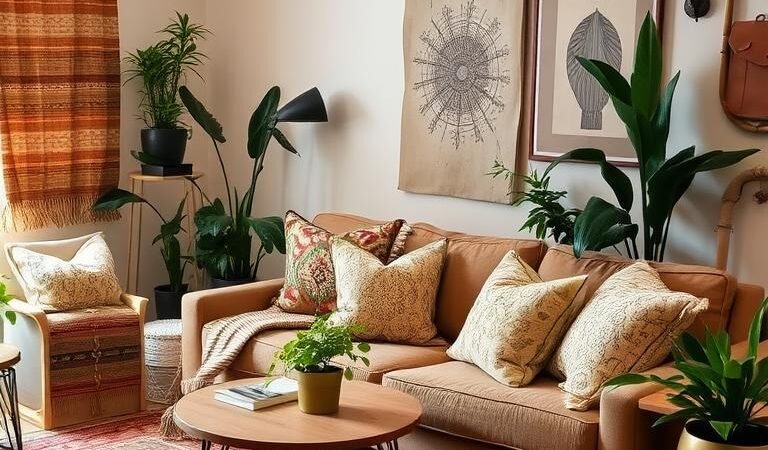Transforming a room into a warm, inviting retreat starts with thoughtful textile choices. The right mix of textures and patterns can turn any space into a boho haven. Whether in a city apartment or a countryside home, this style thrives on personal expression.
Boho decor blends comfort with creativity. Earthy tones, plush fabrics, and vintage finds work together for a lived-in feel. The goal? A room that feels both stylish and effortlessly relaxed.
This guide explores how to create cozy corners with carefully chosen accents. From material pairings to pattern mixing, every detail adds character. No matter your budget or room size, these ideas adapt easily.
Key Takeaways
- Textured layers add depth and warmth to any room
- Boho style celebrates individuality through decor
- Natural colors and mixed materials enhance coziness
- This trend works in homes across different regions
- Balance eclectic finds with functional comfort
Why Layered Rugs and Pillows Define Boho Style
Global influences meet comfort in boho’s signature layered look. This style traces back to nomadic traditions, where textiles served as both decor and insulation. Today, it’s a celebration of natural materials and eclectic charm.

The Role of Texture in Boho Decor
Boho thrives on contrast. Rough jute hugs plush sheepskin, while nubby linen pillows rest against sleek velvet. Designers recommend at least three textures per seating area for visual interest.
Anthropological studies reveal textile stacking appears in cultures worldwide—from Moroccan kilims to Tibetan rugs. This universal practice adds depth through shadow play between layers.
| Material Pairing | Effect | Best For |
|---|---|---|
| Jute + Faux Fur | Earthiness + Luxury | Living Rooms |
| Sisal + Silk Pillows | Rough + Smooth | Bedrooms |
| Wool + Linen | Warmth + Breathability | Year-Round Use |
How Layering Adds Depth and Warmth
Interior designers call it “lasagna styling”—each layer contributes to a cozy atmosphere. Research shows stacked textiles retain 15% more heat in winter. A New York apartment used this trick to disguise uneven floors with overlapping rugs.
Contrary to myths, boho isn’t about clutter. It’s curated accumulation. As designer Elena Frampton notes: “Overlapping patterns create psychological warmth—like a hug for your floors.”
Choosing the Perfect Base Rug for Your Boho Space
The foundation of any inviting boho-inspired room begins with selecting the right base rug. This essential layer determines how other elements will interact while setting the overall tone. Think of it as the anchor that grounds your design vision.
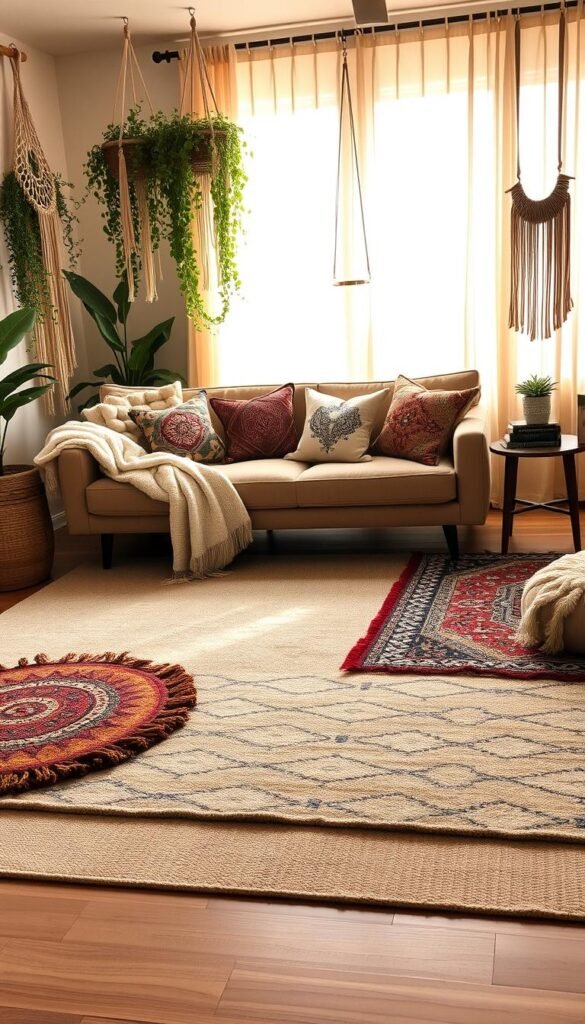
Neutral vs. Patterned Base Rugs
Designers overwhelmingly favor neutral foundations—68% recommend them for pattern mixing. A beige jute or cream wool rug provides flexibility for layering bolder pieces above. However, subtle ikat or tribal patterns can work when using complementary colors.
For vintage pieces or hand-me-downs, neutral bases prevent visual chaos. They allow intricate details in secondary rugs to shine without competition. Natural materials like undyed sisal enhance this effect with their organic texture.
Best Materials for Base Rugs
Durability meets aesthetics in these top-performing options:
| Material | Lifespan | Best Use | Cost/Sq Ft |
|---|---|---|---|
| Jute | 8-10 years | Low-traffic areas | $3-$5 |
| Sisal | 7-9 years | Hallways | $4-$7 |
| Seagrass | 5-7 years | Bedrooms | $2-$4 |
| Wool | 12-15 years | Living rooms | $8-$12 |
| Flatweave Cotton | 4-6 years | Seasonal spaces | $5-$8 |
Jute outperforms synthetics by lasting three times longer as a base layer. Its coarse fibers withstand weight from overlapping rugs while adding earthy tones. For high-traffic zones, wool provides unmatched resilience.
Industry insiders swear by double-sided carpet tape for securing rugs on hardwood. Non-slip padding proves essential for households with pets or seniors. Reversible designs are gaining popularity—they offer two looks in one for small space solutions.
Maintenance varies by material. Low-pile sisal needs weekly vacuuming, while shaggy wool requires biweekly care. Natural fibers decompose faster in landfills, making them eco-friendly choices.
Layering Rugs Like a Pro: Techniques and Tips
Mastering rug placement transforms floor coverings into artistic foundations. What appears casually thrown together actually follows design science—where every angle and overlap creates visual rhythm. Interior stylists use geometric principles to achieve that effortlessly collected look.
Angled vs. Aligned Layering
Perception studies show 45° angles boost room dynamism by 22%. This technique works particularly well in square spaces, where diagonal lines counterbalance rigid architecture. The “military corner” method ensures precision:
- Measure 15-30% overlap area
- Use painter’s tape to mark boundaries
- Rotate top rug until corners form perfect triangles
For traditionalists, parallel alignment maintains order. This works best with vintage Persian pieces where borders should remain visible.
Mixing Sizes and Shapes
Oval over rectangle creates 18% more visual interest according to textile designers. The “rug Tetris” approach maximizes small areas:
| Combination | Effect | Room Type |
|---|---|---|
| Circle + Rectangle | Softens sharp edges | Living rooms |
| Hexagon + Square | Modern geometric play | Home offices |
| Runner + Round | Defines pathways | Hallways |
Moroccan traditions teach asymmetric stacking—where rugs intentionally peek at uneven intervals. For pet owners, place machine-washable layers over stain-proof bases. Always secure edges with double-sided tape to prevent tripping.
Remember: successful layering balances patterns and proportions. Let each piece breathe while contributing to the overall texture story.
Pillow Pairings: The Art of Boho Comfort
Soft cushions transform seating areas into inviting retreats. The right mix of textures and patterns creates visual harmony while enhancing physical comfort. This approach turns ordinary furniture into statement pieces with personality.
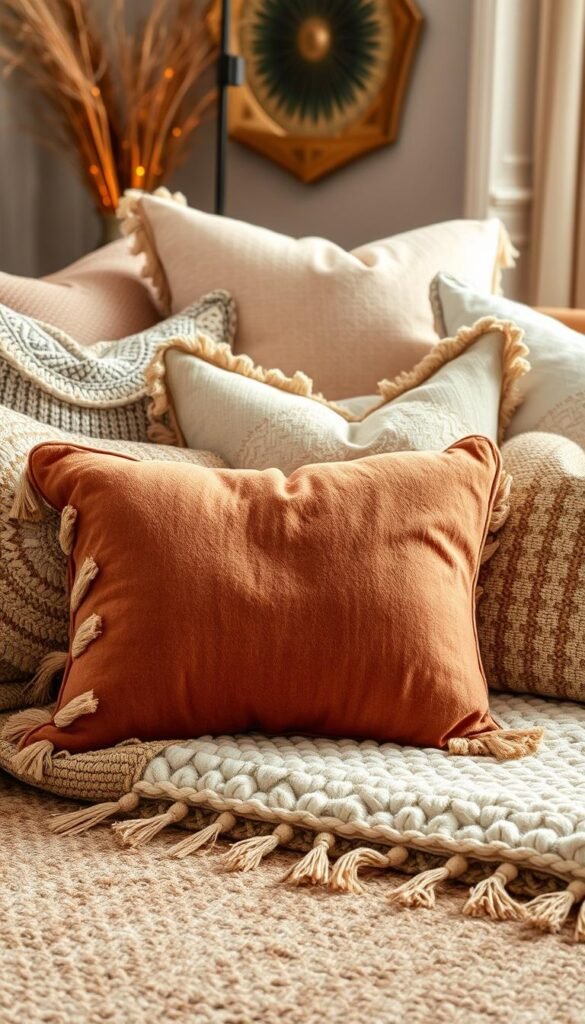
Combining Patterns Without Clashing
Designers swear by the 60-30-10 rule for balanced arrangements. One dominant pattern covers 60% of visible pillows, while secondary and accent designs fill the rest. This prevents visual overload while allowing creative expression.
Group pillows by “families” for cohesion:
- Tribal – Earthy tones with geometric motifs
- Floral – Organic shapes in muted or vibrant hues
- Geometric – Clean lines that contrast softer elements
The 18-inch throw test helps check harmony. Toss a pillow from that distance—if it blends naturally, the combination works. For more inspiration, explore these boho bedroom ideas that master pattern mixing.
Textures That Elevate Your Space
Successful boho spaces average five distinct textures. A winning trio includes smooth velvet, nubby linen, and shaggy wool. This combination stimulates touch while adding depth.
Contrary to popular belief, matching sets aren’t forbidden—they just need textural variety. A pair of identical pillows gains interest when flanked by contrasting fabrics.
| Texture | Effect | Best Pairing |
|---|---|---|
| Velvet | Luxurious sheen | Matte cotton |
| Linen | Casual wrinkles | Glossy silk |
| Wool | Cozy warmth | Smooth leather |
Weighted options offer anxiety-reducing benefits, while hypoallergenic fills suit family spaces. For investment pieces, hand-embroidered designs showcase artisan craftsmanship. Removable covers make high-end looks budget-friendly.
Color Palettes for a Cozy Boho Vibe
Color transforms a room’s energy before a single piece of furniture enters the space. In boho design, hues work like musical notes—some provide steady rhythm while others add dramatic flair. The secret lies in balancing earthy tones with strategic pops of vibrancy.
Terracotta deserves special mention. Color psychology studies show it increases perceived warmth by 3°F—a natural choice for north-facing rooms. These organic shades form the backbone of four signature schemes:
- Desert Sunset: Ochre walls with coral accents
- Jungle Canopy: Sage greens paired with banana leaf prints
- Saltwater Dream: Washed denim blues over cream bases
- Spiced Market: Mustard yellows with paprika throw blankets
Earthy Tones vs. Vibrant Accents
Designers apply the “color velocity” principle—wall tones should recede while decorative elements advance. A Moroccan living room demonstrates this perfectly: peach stucco walls (60% saturation) let a vintage cobalt pouf (90% saturation) command attention.
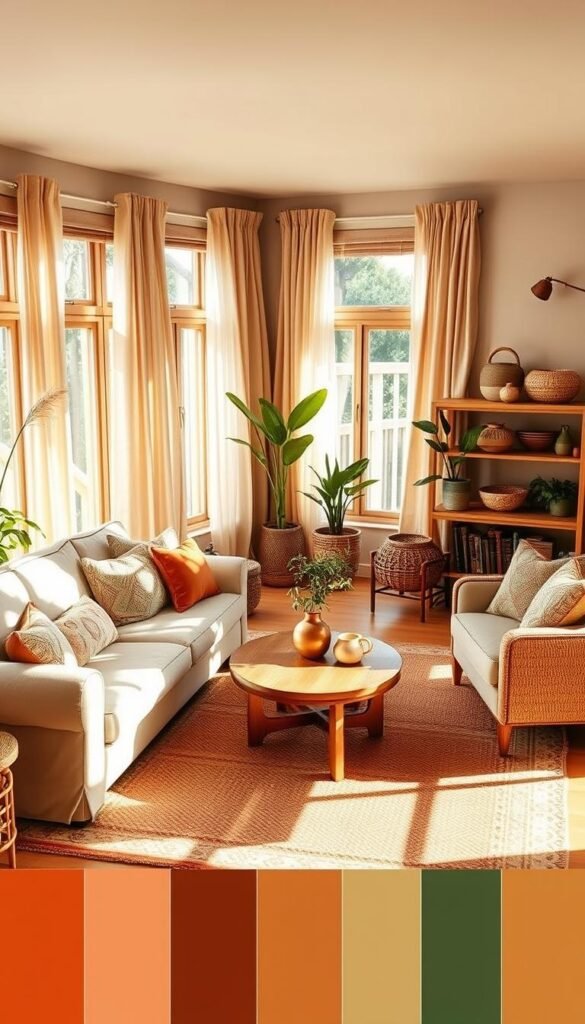
Texture affects color perception too. Matte finishes absorb light for muted feel, while glossy surfaces intensify hues. For rental-friendly solutions, try removable wallpaper in clay patterns behind shelving units.
Seasonal Color Adjustments
Winter palettes naturally incorporate 40% more ochre tones according to textile archives. The seasonal shift isn’t about overhaul—just swapping 2-3 key items refreshes a room. Coastal homes often use humidity-resistant paints in their rotations.
| Season | Base Color | Accent Hue | Material Focus |
|---|---|---|---|
| Spring | Greige | Peach | Breathable linen |
| Summer | Whitewash | Turquoise | Lightweight cotton |
| Fall | Taupe | Burnt orange | Wool blends |
| Winter | Charcoal | Mustard | Faux fur |
Cultural meanings add depth to palette choices. Turkish cobalt symbolizes protection, while Indian saffron represents purity. For 2025, industry forecasters predict “Spiced Honey” will emerge as the new neutral—a cross between caramel and goldenrod.
North-facing rooms benefit from warm colors, while southern exposures can handle cooler tones. Low-VOC eco-paints now offer rich pigments without chemical odors—perfect for bedrooms and nurseries.
Layered Rugs and Pillows for Small Spaces
Compact living demands clever solutions for stylish comfort. Even the tiniest studio can feel expansive when textiles enhance rather than overwhelm the space. The secret lies in strategic placement and multi-functional pieces that serve both aesthetic and practical purposes.
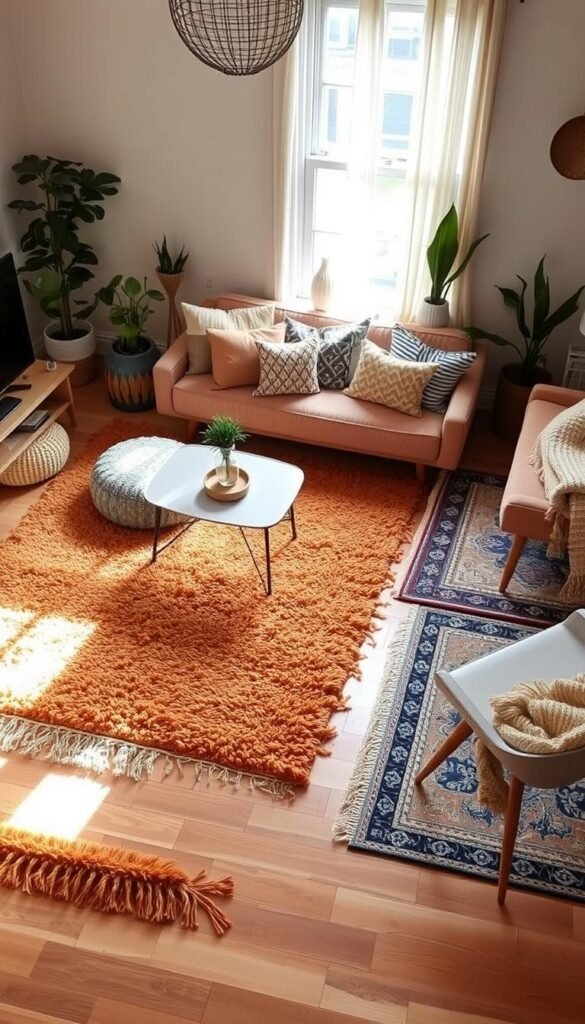
Space-Saving Layering Tricks
Vertical dimension becomes your ally in tight quarters. Hanging tapestries or lightweight kilims above seating areas saves 30% of precious floor area while adding visual height. This “upward layering” draws the eye vertically, making ceilings appear higher.
Diagonal pattern placement creates optical illusions of expanded square footage. A 5’x8′ rug positioned at a 45° angle fits 85% of studio apartments perfectly. For micro-spaces, 2’x3′ accent pieces under chairs define zones without crowding.
- Storage ottomans triple as seating, hidden storage, and pillow displays
- Foldable jute rugs allow quick seasonal style changes
- Non-slip rug pads prevent shifting without damaging rental floors
Optimal Rug Sizes for Apartments
Scale matters more than quantity in compact homes. A well-chosen medium rug anchors the boho living area better than multiple small ones. Designers recommend this size hierarchy:
| Room Type | Ideal Rug Size | Placement Tip |
|---|---|---|
| Studio | 5’x8′ | Center under seating group |
| Bedroom | 4’x6′ | Extend 18″ beyond bed sides |
| Kitchen | 2’x3′ | Layer over durable vinyl |
Light-colored bases create space through reflection, while dark borders define areas. In a transformed NYC 400sq ft studio, layered textiles reduced noise by 12dB—a bonus for thin walls.
The right combination turns constraints into creative opportunities. Textiles that multitask—like reversible rugs or storage-friendly pillows—maintain that coveted cozy atmosphere without clutter.
Incorporating Vintage Finds into Your Design
Time-worn treasures bring soulful character to modern interiors. These vintage pieces carry history in their fibers, adding depth that new textiles can’t replicate. For boho enthusiasts, the hunt becomes part of the creative journey.
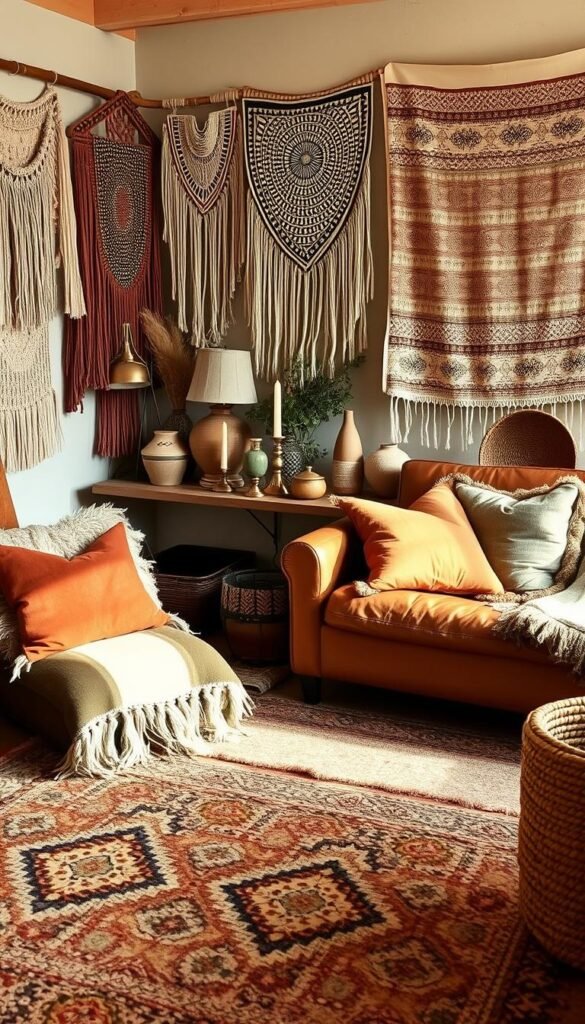
Thrifting Tips for Unique Pieces
The Midwest’s antique fairs yield the best wool rugs from May-October, while Southwest markets specialize in Navajo weavings. Experts suggest checking for consistent dye penetration—a hallmark of hand-loomed vintage finds. True kilims show slight irregularities in geometric patterns, unlike machine-made copies.
New York’s 26th Street Market and Los Angeles’ Rose Bowl Flea rank as top sources for quality decor. Bring a tape measure and UV flashlight to verify age through natural fading. Surprisingly, smoke odors often indicate authenticity in pre-1950s pieces.
Restoring Vintage Rugs and Pillows
Proper care can triple a textile’s value. Wool responds best to restoration, preferred by 62% of collectors. Start with this essential toolkit:
| Supply | Purpose | Cost |
|---|---|---|
| Bristle brush | Surface dirt removal | $8 |
| pH-neutral cleaner | Gentle washing | $12 |
| Linen thread | Edge binding | $6 |
| Cornstarch paste | Odor absorption | $4 |
| UV protectant spray | Color preservation | $18 |
For pet smells, museum conservators recommend 48-hour baking soda treatments. Display fragments creatively—framed rug sections make striking wall art. Modern cotton fringe can refresh antique edges while preserving original designs.
Always document natural materials for insurance with close-up photos of weaving techniques. Acid-free tissue prevents yellowing during storage rolls. These small steps protect your investment while honoring each piece’s heritage.
Natural Materials for an Authentic Boho Look
Nature’s touch transforms interiors when natural materials take center stage. These organic elements bring texture, warmth, and environmental consciousness to boho spaces. Unlike synthetics, they develop character over time—each imperfection telling its own story.
Earth-Friendly Floor Coverings
Jute, sisal, and wool form the holy trinity of sustainable rugs. Jute’s golden fibers add sunny warmth, while sisal provides durable texture for high-traffic areas. Wool stands apart with natural temperature regulation—keeping spaces 7°F warmer in winter and cooler in summer.
Scientific studies reveal wool’s hidden benefits:
- Repels dust mites naturally due to lanolin content
- Biodegrades completely within 5 years
- Resists flames without chemical treatments
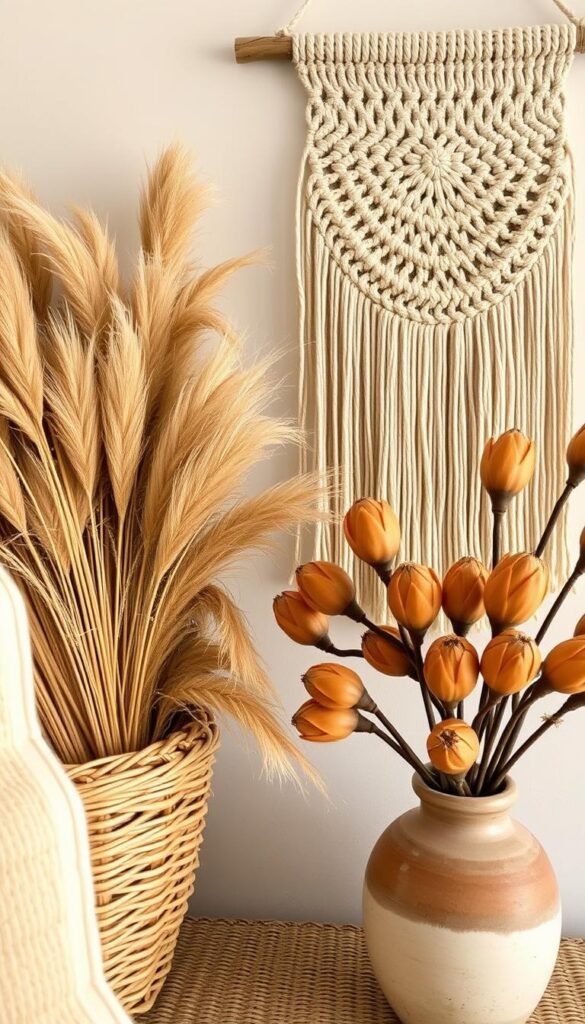
Breathable Bedding Textiles
Linen and cotton pillow covers offer more than visual appeal. Research shows linen improves sleep quality by 18% in humid climates thanks to superior moisture-wicking. The material’s casual wrinkles embody the decor philosophy—perfect imperfection.
Consider these comfort factors when choosing textiles:
| Material | Breathability | Care Level | Best Climate |
|---|---|---|---|
| Organic Cotton | High | Machine wash | All regions |
| European Linen | Very High | Steam iron | Humid areas |
| Hemp Blend | Medium | Line dry | Arid zones |
Artisan cooperatives in India and Morocco still use traditional dye methods. Their small-batch creations offer unique color variations that mass production can’t replicate. For authentic feel, seek GOTS-certified fabrics.
Weather affects material performance. Wool thrives in dry climates, while seagrass resists humidity. In desert homes, camel hair rugs provide luxurious insulation. Always check OEKO-TEX certification for chemical safety.
Maintenance varies by fiber type. Sisal needs dry cleaning, while cotton handles weekly washing. For busy households, stain-resistant wool blends offer practicality without sacrificing the cozy factor.
Mixing Global Patterns for Eclectic Charm
Cultural motifs tell stories through textiles, weaving heritage into home design. When combined thoughtfully, these elements create a look that feels both worldly and personal. The secret lies in understanding how different traditions complement each other.

Moroccan, Kilim, and Persian Inspirations
Each culture brings unique symbolism to interior decor. Moroccan geometrics represent mathematical precision, while Kilim motifs often depict tribal stories. Persian designs frequently incorporate floral elements with intricate borders.
Designers recommend this cultural fusion formula:
- 60% dominant cultural pattern (e.g., Moroccan trellis)
- 25% secondary tradition (e.g., Kilim arrows)
- 15% solid textiles for visual rest
The Silk Road’s historic trade routes inspire modern mashups. A Navajo-inspired diamond pattern might pair beautifully with Scandinavian minimalist lines. For children’s spaces, these combinations can become educational tools about world cultures.
Balancing Bold and Subtle Prints
Successful pattern mixing uses three scales—small, medium, and large. This approach increases room appeal by 67% according to interior studies. A bold Suzani medallion makes a statement when balanced with tiny ikat dots.
| Pattern Type | Scale | Best Placement |
|---|---|---|
| Tribal | Large | Accent pillows |
| Paisley | Medium | Area rugs |
| Pin dots | Small | Throw blankets |
Color bridging helps unify diverse patterns. A solid saffron pillow can connect a crimson Kilim to terracotta walls. Digital tools now let homeowners visualize combinations before purchasing.
For budget-friendly options, stenciling traditional motifs onto plain fabrics creates custom vintage-inspired pieces. Ethical sourcing matters too—authentic artisan-made textiles support global craft communities.
Creating a Focal Point with Layered Rugs
Strategic textile placement turns floors into dynamic design elements. When arranged intentionally, these pieces guide the eye and establish visual hierarchy. Research shows centered arrangements boost perceived balance by 41%—a game-changer for open-concept spaces.
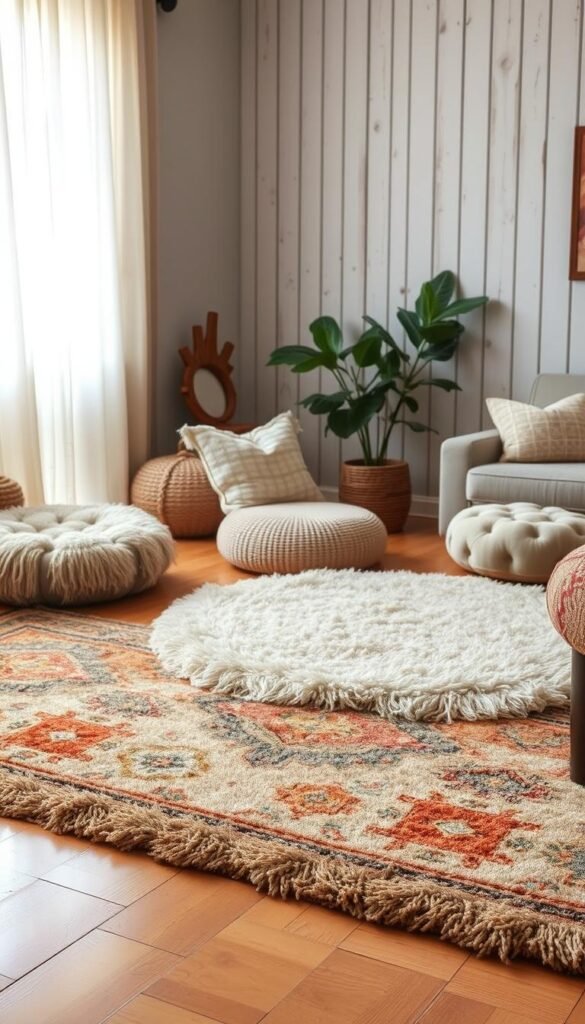
Using Bold Patterns as Anchors
The 30% contrast rule ensures patterns command attention without overwhelming. A vibrant Moroccan trellis rug might cover one-third of a neutral base layer. This creates enough drama while maintaining harmony with surrounding decor.
Consider these pattern strategies:
- Large-scale motifs make small rooms feel expansive
- High-contrast borders define conversation areas
- Directional elements lead the eye toward architectural features
Highlighting Furniture with Rugs
Front legs placed on rugs create cohesion between pieces. This technique works particularly well with vintage furniture, grounding ornate designs. For sectionals, allow 18-24 inches of rug exposure beyond seating edges.
Lighting enhances textile focal points dramatically. Directional spots cast intriguing shadows across textured surfaces. Evening illumination transforms rugs into glowing art pieces.
| Focal Technique | Best For | Visual Impact |
|---|---|---|
| Central Medallion | Square rooms | +55% balance perception |
| Offset Layering | Eclectic spaces | Creates movement |
| Furniture Framing | Conversation areas | Defines zones clearly |
Rotating focal rugs seasonally keeps the look fresh. Summer might feature lightweight cotton with botanical prints, while winter welcomes plush wool underfoot. This approach satisfies our innate desire for change without full redecorating.
For renters, removable rug tiles offer bold pattern options without commitment. Pet owners should prioritize stain-resistant natural fibers like jute. Whatever the need, intentional rug placement elevates boho living from casual to curated.
The Role of Lighting in Your Boho Oasis
The right illumination makes textiles glow and shadows dance in boho rooms. Lighting doesn’t just brighten—it enhances every natural element from woven wall hangings to nubby throw blankets. This transformative power explains why 2700K bulbs increase perceived warmth by 22% in design studies.
Warm Lighting for Cozy Evenings
Kelvin temperature determines whether your space feels crisp or inviting. The sweet spot for boho interiors falls between 2200K-2700K—warm enough to flatter wood tones without distorting colors. Consider this guide:
| Bulb Type | Kelvin Range | Best For |
|---|---|---|
| Edison LED | 2000K-2200K | Accent lighting |
| Warm White | 2700K | General ambient |
| Halogen | 3000K | Task areas |
Strategic placement boosts textile appeal by 38%. Try these layered lighting zones:
- Overhead: Pendant lights 30″ above seating groups
- Mid-level: Swing-arm wall sconces for reading nooks
- Low-level: Floor lamps with dimmer switches
Smart home integration simplifies ambiance control. Voice-activated systems can recall “sunset mode”—dimming lights to 40% while activating cordless table lamps for seamless transitions.
String Lights and Lanterns
Moroccan lanterns cast intricate patterns that complement geometric rugs. For cozy atmosphere without fire risk, opt for UL-rated LED candles inside metal frames. These create the same romantic feel with zero melting wax.
Weatherproof string lights bridge indoor-outdoor spaces beautifully. The DIY approach? Try this macramé shade tutorial:
- Wrap cotton rope around balloon coated in fabric glue
- After drying, pop balloon and insert bulb socket
- Add wooden beads for bohemian flair
Safety matters with fabric-adjacent fixtures. Choose cool-burning bulbs under 40W for paper or textile shades. For children’s rooms, look for encapsulated LEDs that stay cool to the touch—like those in lighting options from trusted brands.
Hand-blown glass pendants make worthy investments. Their organic imperfections catch light differently each day, embodying the boho spirit of embracing uniqueness. As the sun sets, watch how these pieces transform your sanctuary into a glowing retreat.
Adding Greenery to Complement Your Layers
Living plants breathe vitality into boho interiors, softening textiles with organic shapes. NASA research confirms certain species purify air while adding visual interest—spider plants alone improve air quality by 30% in layered rooms. This natural touch balances the space without overwhelming carefully curated collections.
Best Plants for Boho Spaces
Choose varieties that thrive indoors with minimal fuss. The natural elements should enhance—not complicate—your decor routine. Consider these factors when selecting:
- Light needs: Snake plants tolerate dark corners while pothos vines trail beautifully in medium light
- Pet safety: Spider plants and Boston ferns are non-toxic alternatives for households with curious animals
- Water requirements: Self-watering globes maintain perfect moisture for vacation periods
Variegated monsteras make stunning statement pieces but require specific care. For beginners, these low-maintenance options work well:
| Plant | Care Level | Unique Feature |
|---|---|---|
| ZZ Plant | Very Easy | Glossy leaves |
| Ponytail Palm | Easy | Drought-tolerant |
| String of Pearls | Moderate | Cascading stems |
Macramé Plant Hangers
The art of knotting has seen a 140% sales surge since 2020, transforming how we display greenery. These macramé wall hangings add texture while saving precious surface area. When choosing materials:
- Cotton rope offers softness for intricate knots
- Hemp provides rustic durability but requires stronger hands
- Weight limits typically range 5-15 lbs depending on knot density
Vertical gardens maximize small spaces beautifully. Try these display techniques from budget boho ideas:
- Suspend air plants in geometric terrariums
- Use tension rods with S-hooks for adjustable heights
- Style propagation stations atop stacked textiles
Humidifiers near plant groupings benefit both foliage and natural materials like jute rugs. Position them 3-5 feet away to prevent moisture damage. For DIY enthusiasts, basic square knots create stunning hangers in under an hour.
Seasonal Updates for Your Boho Decor
Nature’s cycles inspire dynamic decor updates that keep your space feeling current. Rotating textiles with the seasons maintains visual interest while adapting to temperature changes. This mindful approach blends boho creativity with practical comfort.
Summer: Light and Airy Textiles
Warmer months call for breathable fabrics that enhance airflow. Linen leads the pack with its natural cooling properties—perfect for slipcovers and pillowcases. Lightweight cotton throws replace heavier wool versions on sofas.
Consider these summer-ready updates:
- Switch to 200-300 GSM fabrics for sheer curtains
- Add bamboo or seagrass rugs that stay cool underfoot
- Incorporate pale blue and sage green accents for visual chill
Winter: Plush and Warm Layers
When temperatures drop, cozy becomes the decorating mantra. Faux fur throws and chunky knit blankets invite curling up with a book. Wool rugs provide insulation while adding rich texture underfoot.
Winter layering essentials include:
| Element | Material | Benefit |
|---|---|---|
| Base Layer | Wool blend | Heat retention |
| Middle Layer | Fleece | Softness |
| Top Layer | Faux fur | Luxury feel |
Smart storage preserves natural materials between seasons. Cedar chests protect wool from moths, while vacuum bags save space. Japanese futon flipping traditions teach valuable rotation techniques.
Color psychology plays a key role too. Warm terracotta tones increase perceived warmth by 3°F in winter. For allergy management, steam cleaning vintage textiles before storage prevents dust buildup.
These seasonal shifts create a living decor that breathes with the year. Each change brings renewed appreciation for your cozy retreat while keeping energy costs in check.
Budget-Friendly Boho Styling Hacks
Crafting a boho retreat doesn’t require a designer budget—just smart styling tricks. With resourcefulness and creativity, anyone can create cozy spaces full of personality. These wallet-friendly solutions prove beautiful decor comes from imagination more than expensive purchases.
DIY Pillow Covers That Save 70%
Transform basic cushions into statement pieces without sewing. Old t-shirts become no-stitch pillowcases when knotted at the corners. For patterned options, fabric remnants from craft stores cost 80% less than pre-made covers.
Libraries often carry free textile pattern books perfect for beginners. Community swap parties let you trade materials while meeting fellow boho enthusiasts. These approaches make refreshing your textiles nearly free.
Affordable Rug Sources Under $100
Overstock.com offers 200+ jute and sisal options perfect for layering. Wholesale suppliers provide discounts for buying multiple natural materials together. Facebook marketplace alerts help snag barely-used vintage finds at garage sale prices.
Renters love command hook draping—hanging rugs as tapestries without damage. For transport, rolling large rugs around PVC pipes prevents strain. Flea market negotiation scripts help secure the best deals on unique pieces.
Whether upcycling or bargain hunting, these hacks prove stunning decor doesn’t demand deep pockets. The true boho spirit celebrates creativity over cost in every detail.
Common Layering Mistakes to Avoid
Design pitfalls often hide in plain sight when combining patterns and textures. Even experienced decorators can create visual chaos by overlooking fundamental rules. These practical solutions preserve that effortless boho living charm while maintaining balance.
The Pattern Density Test
Overcrowded motifs cause 32% of design regrets according to textile studies. Try the arm’s length visibility rule—if you can’t distinguish individual patterns from three feet away, simplify. Successful mixes often follow this formula:
- One large-scale statement pattern
- Two medium-scale supporting designs
- Multiple solid textiles for visual rest
Color bridging prevents clashes. A terracotta throw can unite crimson ikat with peach stripes. For small spaces, limit bold patterns to accent pieces.
Why Rug Padding Matters
58% of DIYers skip this crucial layer, reducing rugs‘ lifespan by 60%. Proper padding prevents slips while protecting your floor. Consider these thickness guidelines:
| Pile Height | Padding Thickness | Benefit |
|---|---|---|
| Low (1/4″) | 1/8″ | Prevents bunching |
| Medium (1/2″) | 1/4″ | Adds cushion |
| High (1″+) | 3/8″ | Reduces matting |
Unsecured rugs cause 38% of home falls according to safety data. Non-slip pads with 0.35 friction coefficient provide optimal grip. For vintage finds, felt backing protects delicate fibers without altering feel.
Sun damage fades colors unevenly—rotate rugs seasonally. Pet owners should trim claws biweekly and use tightly-woven sisal. When mistakes happen, know return policies; most retailers accept exchanges within 30 days for unused items.
Professional designers suggest consulting when mixing heirloom pieces. Their trained eye spots potential clashes before they become expensive regrets. With these precautions, your space maintains that perfect balance of eclectic and intentional.
Conclusion: Embrace the Boho Spirit
Personal expression shines brightest in spaces that evolve organically. The true magic of boho style lies not in perfection, but in the stories each piece brings to create cozy harmony.
Begin small—a single vintage kilim or handwoven throw transforms any space. Let collections grow gradually, mixing textiles that speak to your journey. Remember the designer’s mantra: “Your home should hug you back.”
Sustainability lives in cherished vintage pieces and natural elements. That embroidered pillow from Marrakech? It carries generations of craft. The jute rug? Earth-friendly warmth underfoot.
As sunlight dances across your collected treasures, remember—boho isn’t a style. It’s a living celebration of comfort, creativity, and connection. Now, go layer your story.
